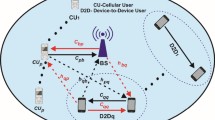Abstract
Underlay device-to-device (D2D) communication in cellular networks has been considered as a promising technique that can improve the spectral efficiency of cellular systems and meet the growing demand for wireless local services. In underlay D2D, it is of primary importance to manage the mutual interference between cellular links and D2D links through effective resource allocation. While most of previous works on D2D resource allocation are developed based on the knowledge of the channel state information (CSI) on the interference channels as well as the desired channels, it is hard to obtain full CSI in practice. Accordingly, we consider D2D resource allocation schemes based on distance between nodes. In particular, we formulate two optimization problems for D2D resource allocation using the outage probability computed based on the distance information as cost functions. One is a linear sum assignment problem (LSAP) and the other is a linear bottleneck assignment problem (LBAP). By applying the graph theory, we provide efficient algorithms for solving the optimization problems. Numerical results are provided to show the effectiveness of the proposed optimization as compared to previously proposed distance-based resource allocation algorithms.












Similar content being viewed by others
Notes
Note that the proposed resource allocation algorithms shall inherently provide fairness among D2D pairs in the sense that all the D2D pairs are allocated the same amount of resources
References
Burkard R, Dell’Amico M, Martello S (2012) Assigment Problems SIAM. Philadelphia
Cormen T H, Leiserson C E, Rivest R L (1990) Introduction to Algorithms. MIT Press McGraw-Hill
Corson M S, Laroia R, Li J, Park V, Richardson T, Tsirtsis G (2010) Toward proximity-aware internetworking. IEEE Wireless Commun 17(6):26–33
Doppler K, Rinne M, Wijting C, Ribeiro C, Hugl K (2009) Device-to-device communication as an underlay to LTE-advanced networks. IEEE Commun Mag 47(12):42–49
Doumi T, Dolan M F, Tatesh S, Casati A, Tsirtsis G, Anchan K D F (2013) LTE for public safety networks. Commun, I E E E Mag 51(2):106–113
Duong Q, Shin Y, Shin OS (2013) Resource allocation scheme for device-to-device communications underlaying cellular networks IEEE Inter. Conf. Computing, Management Telecommun. 2013 (ComManTel 2013), pp 66–69
Fodor G, Dahlman E, Mildh G, Parkvall S, Reider N, Miklos G, Turanyi Z (2012) Design aspects of network assisted device-to-device communications. IEEE Commun Mag 50(3):170–177
Gross J L, Yellen J (2005) Graph Theory and Its Applications, 2nd Ed. CRC Press, New York
Han J, Cui Q, Yang C, Valkama M, Tao X (2014) Optimized power allocation and spectrum sharing in device to device underlaying cellular systems Proc. IEEE Wireless Commun. Networking Conf. 2014 (WCNC 2014), pp. 1332–1337
Janis P, Koivunen V, Ribeiro C, Korhonen J, Doppler K, Hugl K Interference-aware resource allocation for device-to-device radio underlaying cellular networks Proc IEEE Veh Technol Conf, 2009, Spring (VTC,2009,Spring),pp. 1–5 (2009)
Jonker R, Volgenant A (1987) A shortest augmenting path algorithm for dense and sparse linear assignment problems. Comput 38(4):325–340
Lee J, Song H, Oh S, Hong D (2006) An improved location tracking algorithm with velocity estimation in cellular radio networks Proc IEEE Veh Technol Conf 2006 Spring (VTC 2006 Spring), pp618–622
Lei L, Zhong Z, Lin C, Shen X (2012) Operator controlled device-to-device communications in LTE-advanced networks. IEEE Wireless Commun 19(3):96–104
Martin H, Rudolf M (1999) Location tracking of mobiles in cellular radio networks. IEEE Trans Veh Technol 48(5):1558–1562
Min H, Seo W, Lee J, Park S, Hong D (2011) Reliability improvement using receive mode selection in the device-to-device uplink period underlaying cellular networks. IEEE Trans Wireless Commun 10(2):413–418
Motwani R, Raghavan P (1995) Randomized Algorithms Cambridge Univ Press UK
Nguyen H V, Duong Q, Shin O S, Resource allocation optimization for device-to-device communications in cellular networks (2014) Proc Inter Conf ICT Convergence 2014 (ICTC 2014), pp 377–378
Wang B, Chen L, Chen X, Zhang X, Yang D (2011) Resource allocation optimization for device-to-device communication underlaying cellular networks Proc IEEE Veh Technol Conf 2011 Spring (VTC 2011 Spring), pp 1–5
Wang H, Chu X (2012) Distance-constrained resource-sharing criteria for device-to-device communications underlaying cellular networks. IET Electron Lett 48(9):528–530
Wang H, Xia K, Chu X (2013) On the position-based resource-sharing for device-to-device communications underlaying cellular networks Proc. IEEE/CIC Inter. Conf. Commun. China 2013 (ICCC 2013), pp 135–140
Yu C H, Tirkkonen O, Doppler K, Ribeiro C (2009) On the performance of device-to-device underlay communication with simple power control Proc. IEEE Veh. Technol. Conf. 2009 Spring (VTC 2009 Spring), pp 1–5
Yu C H, Tirkkonen O, Doppler K, Ribeiro C (2009) Power optimization of device-to-device communication underlaying cellular communication Proc IEEE Inter Conf Commun 2009 (ICC 2009), pp 1–5
Acknowledgments
This work was supported by the National Research Foundation of Korea (NRF) grant funded by the Korea government (MSIP) (No. 2013R1A2A2A01011222).
Author information
Authors and Affiliations
Corresponding author
Rights and permissions
About this article
Cite this article
Nguyen, H.V., Duong, Q., Nguyen, VD. et al. Optimization of resource allocation for underlay device-to-device communications in cellular networks. Peer-to-Peer Netw. Appl. 9, 965–977 (2016). https://doi.org/10.1007/s12083-015-0357-8
Received:
Accepted:
Published:
Issue Date:
DOI: https://doi.org/10.1007/s12083-015-0357-8




